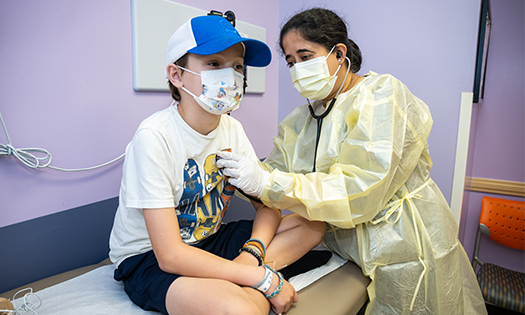Iron deficiency anemia is a common childhood health issue and is usually treated successfully in the primary care setting with a combination of iron supplements and dietary modifications. But what if a patient’s hemoglobin doesn’t rise after three months of treatment?
Persistent iron deficiency anemia can be the harbinger of an underlying condition, such as a hereditary blood disorder or an intestinal disease. But identifying the secondary etiology and the appropriate treatment can be tricky.
Children's Health℠ offers care from some of the nation's top pediatric hematology experts who use sophisticated protein assays, blood analysis and years of specialized experience to understand what’s causing iron deficiency and how to help. Here are some tips on when to refer for this condition and some insights on which diagnostic and treatment steps might be next.
The Big Picture: 3 Scenarios That Warrant Referral
There are three distinct scenarios for which children are typically referred, notes Erin Butler, M.D., Pediatric Hematologist in the Center for Cancer and Blood Disorders (CCBD) at Children’s Health and Assistant Professor at UT Southwestern.
Difficulty tolerating iron therapy: Difficulty tolerating iron supplements is the most common reason children are referred to a specialist for iron deficiency anemia.
“Iron supplements aren’t delicious or easy on the stomach and many children, especially young ones, have difficulty staying with it,” says Dr. Butler. “Our team spends time with patients and their families to provide thorough education and nutritional guidance. We also have some tips and tricks that can help them be more compliant, like taking the iron supplement at bedtime with OJ and avoiding products containing milk.”
Children’s Health can also provide IV iron infusions to rapidly replete iron stores for those children who are unable to tolerate oral iron for medical reasons, such as short gut syndrome, renal disease, or allergy to oral iron formulations.
Adherence to treatment, but no response: Sometimes, a child complies with iron therapy yet their hemoglobin still doesn’t come up. The iron stores of these children are often normal, but their red blood cells are small and pale, which usually indicates an underlying hemoglobinopathy like beta thalassemia or alpha thalassemia trait.
“It can take a bit of digging to identify the underlying blood disorder a child has and what type of care they’ll need going forward,” says Dr. Butler. “Though we usually can make a diagnosis with a comprehensive family history and a detailed analysis of a blood smear, our team offers hemoglobin electrophoresis – interpreted by our wonderful Hematopathology colleagues at UT Southwestern – when needed.”
Counseling families about the inheritance pattern of their child’s hemoglobinopathy, what to anticipate in the years ahead, and whether other members of the family should be tested is also part of being cared for at CCBD.
Iron deficiency in the adolescent patient: Patients in this category are often post-pubescent teens. Some of these patients have heavy frequent bleeding events, like menorrhagia. Others have an inflammatory bowel disease (IBD) that interferes with their ability to absorb nutrients. Occasionally, the clinic sees extreme athletes whose activities lead to increased hemoglobin breakdown and decreased iron utilization.
“Identifying the cause of refractory iron deficiency anemia in the older teenage patient can be difficult,” says Dr. Butler. “We offer comprehensive diagnostic tools not readily available in the community and expertise interpreting test results to pinpoint the cause of a patient’s iron deficiency. One of the benefits of being plugged into the Children’s Health system is that we can connect patients to highly specialized services where they will receive care from leaders in the field and may also have access to clinical trials studying the latest treatments.
Teens with IBD are referred to the renowned gastroenterology program. Girls with heavy periods are seen in the Young Women’s Blood Disorder Program, one of only three programs in the U.S. focusing on bleeding disorders that affect pediatric and adolescent girls. Dr. Ayesha Zia’s innovative research is making care in this area even better.
Why Children’s Health: A Legacy of Excellence, a Future of Innovation
Children’s Health has the largest cancer and blood disorders program in North Texas and offers state-of-the-art care in specialties spanning the field. Most of the team’s hematologists trained with UT Southwestern professor emeritus George Buchanan, M.D., one of the nation’s most influential hematologists. Dr. Buchanan led the development of the current practice guidelines for treating iron deficiency anemia.
“When children come to Children’s Health they become part of a system with broad clinical expertise. A pediatric hematologist is on call 24/7 so we can collaborate with our colleagues in the community at any time,” Dr. Butler says. “We also offer one of the nation’s most diverse pediatric hematology research portfolios and are actively working to improve care on chronic issues from thrombosis to sickle cell disease.”
Related podcast: Dr. Butler discusses caring for iron deficiency anemia in children in this episode of the Pediatric Insights podcast. Listen now.
Read more about the innovative cancer and blood disorders care and research at Children’s Health.
You can also call 214-456-2978 to consult about a patient or discuss if a referral is indicated.


